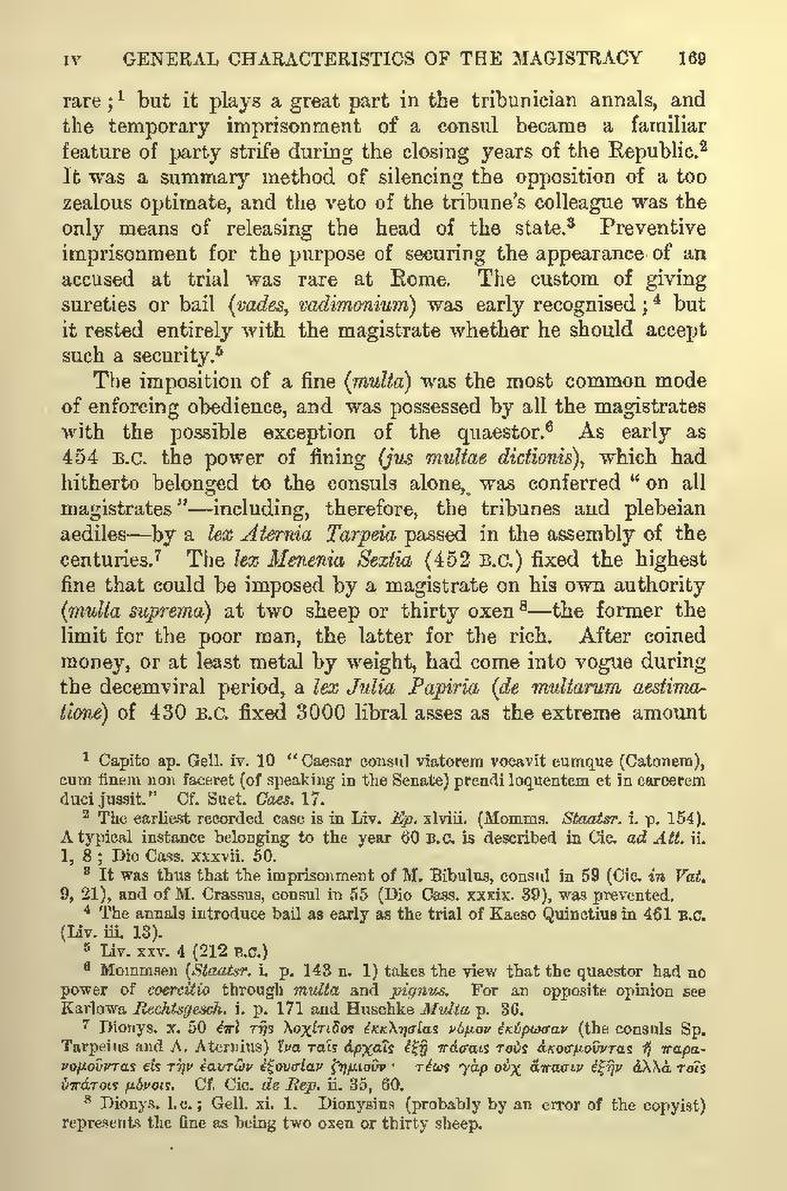rare;[1] but it plays a great part in the tribunician annals, and the temporary imprisonment of a consul became a familiar feature of party strife during the closing years of the Republic.[2] It was a summary method of silencing the opposition of a too zealous optimate, and the veto of the tribune's colleague was the only means of releasing the head of the state.[3] Preventive imprisonment for the purpose of securing the appearance of an accused at trial was rare at Rome. The custom of giving sureties or bail (vades, vadimonium) was early recognised;[4] but it rested entirely with the magistrate whether he should accept such a security.[5]
The imposition of a fine (multa) was the most common mode of enforcing obedience, and was possessed by all the magistrates with the possible exception of the quaestor.[6] As early as 454 B.C. the power of fining (jus multae dictionis), which had hitherto belonged to the consuls alone, was conferred "on all magistrates"—including, therefore, the tribunes and plebeian aediles—by a lex Aternia Tarpeia passed in the assembly of the centuries.[7] The lex Menenia Sextia (452 B.C.) fixed the highest fine that could be imposed by a magistrate on his own authority (multa suprema) at two sheep or thirty oxen[8]—the former the limit for the poor man, the latter for the rich. After coined money, or at least metal by weight, had come into vogue during the decemviral period, a lex Julia Papiria (de multarum aestimatione) of 430 B.C. fixed 3000 libral asses as the extreme amount(the consuls Sp. Tarpeius and A. Aternius) [Greek: hina tais archais exê pasais tous akosmountas ê paranomountas eis tên heautôn exousian zêmioun; teôs gar ouch hapasin hexên anga tois hypatois monois]. Cf. Cic. de Rep. ii. 35, 60.]
- ↑ Capito ap. Gell. iv. 10 "Caesar consul viatorem vocavit eumque (Catonem), cum finem non faceret (of speaking in the Senate) prendi loquentem et in carcerem duci jussit." Cf. Suet. Caes. 17.
- ↑ The earliest recorded case is in Liv. Ep. xlviii. (Momms. Staatsr. i. p. 154). A typical instance belonging to the year 60 B.C. is described in Cic. ad Att. ii. 1, 8; Dio Cass. xxxvii. 50.
- ↑ It was thus that the imprisonment of M. Bibulus, consul in 59 (Cic. in Vat. 9, 21), and of M. Crassus, consul in 55 (Dio Cass. xxxix. 39), was prevented.
- ↑ The annals introduce bail as early as the trial of Kaeso Quinctius in 461 B.C. (Liv. iii. 13).
- ↑ Liv. xxv. 4 (212 B.C.)
- ↑ Mommsen (Staatsr. i. p. 143 n. 1) takes the view that the quaestor had no power of coercitio through multa and pignus. For an opposite opinion see Karlowa Rechtsgesch. i. p. 171 and Huschke Multa p. 36.
- ↑ Dionys. x. 50 [Greek: epi tês lochitidos ekklêsias nomon ekyrôan
- ↑ Dionys. l.c.; Gell. xi. 1. Dionysius (probably by an error of the copyist) represents the fine as being two oxen or thirty sheep.
